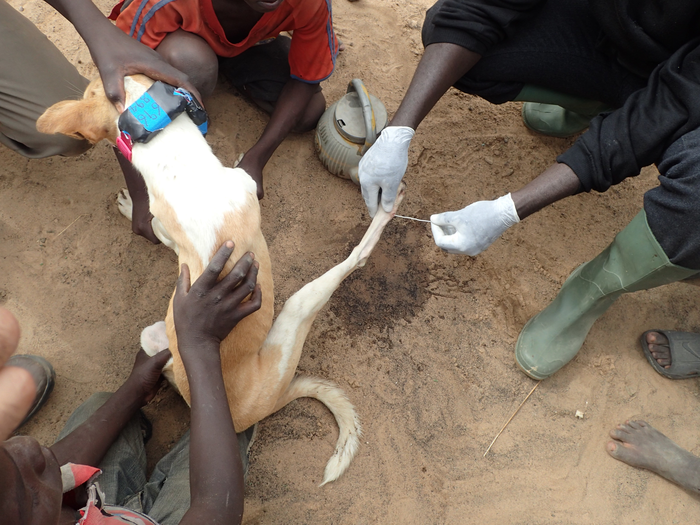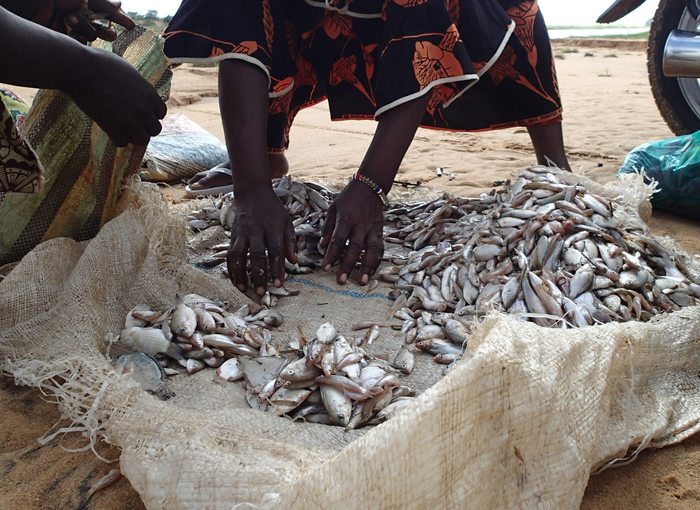Guinea worm disease is targeted for eradication. It would be the second human disease to be eradicated. The first being smallpox. Guinea worm eradication programs have drastically reduced human cases of the infection from millions a year in the 1980s to just 27 in 2020.
However, just as eradication appeared imminent, the Guinea worm has emerged in dogs. Targeted surveillance showed that in 2020, 93% of Guinea worms detected worldwide were in dogs in Chad, in central Africa.
A new study now shows efforts to eradicate Guinea worm disease are being thwarted by dogs eating infected fish.
The paper titled ‘Seasonal fishery facilitates a novel transmission pathway in an emerging animal reservoir of Guinea worm’ published in the journal Current Biology on December 14, reports on how scientists at the University of Exeter in UK have measured and analyzed variations in Guinea worm emergence in dogs in Chad over three seasons in several villages and districts.

Guinea worm disease (dracunculiasis) spreads through contaminated drinking water that carries the parasite’s larvae. Although an infected person shows no symptoms for about a year, the worm grows in the host’s body causing fever, nausea, diarrhea, and even tetanus or sepsis. After a 10-to-14-month incubation period in the host, a blister develops, usually on the skin in the lower extremities, through which the meter-long adult worm emerges to shed its larvae back into water.
While the death rate due to dracunculiasis is low, the parasite causes temporary or permanent disability, debilitating pain and trauma in the poorest 10% of the world’s population who have no access to safe drinking water or health care, including Chad, Ethiopia, Mali and South Sudan. Guinea Worm Disease is both a disease of poverty and a cause of poverty, notes the US Centers for Disease Control and Prevention.
The current study provides evidence to show that dogs that eat fish that carry the parasite larvae help maintain the Guinea worm’s life cycle, providing a novel route of transmission of the disease to humans.
Robbie McDonald, PhD, professor at Exeter’s Environment and Sustainability Institute and senior author of the study says, “This study substantiates a novel pathway for transmission of Guinea worm disease, in the major reservoir species, dogs. To eradicate the disease worldwide in all hosts, it must now be eliminated in animals as well as humans.”
The researchers worked for a year in several of the worst-affected villages along the River Chari in Chad. They tracked hundreds of dogs with GPS satellite tags to analyze movements and uncovered their diets throughout the year using forensic stable isotope analysis of dog whiskers.
“Our application of forensic stable isotope analysis adopts a novel approach whereby diet was reconstructed back in time, over the lifetime of growth of the dog whiskers. This works because the whiskers are constantly growing and the stable isotope signature at the time of whisker formation is fixed and reflects diet at that time. We use this signature, together with those of potential food sources groups – particularly fish in this study – to reconstruct dog diets. We then compared these to variation in risk over time,” says McDonald.
The researchers show that much of the fish that the dogs ate, usually guts or small fish, was discarded by humans fishing on the river and its lagoons. At the end of the hot-dry season and beginning of the wet season, when fishing by people is most intensive, the researchers show Guinea worm emergence rates in dogs were highest, and fish consumption in dogs was most closely associated with disease.
“Dogs are now the key impediment to eradicating this dreadful human disease,” says McDonald. “Our work shows that fisheries, and the facilitation of dogs eating fish, are likely contributing to the persistence of Guinea worm in Chad.”

McDonald says, “This is a clear example where a ‘One Health’ approach to integrating health of people, animals and the environment is required to eradicate this debilitating human disease.”
The research group is now moving forward to figure out the best way to intervene in the consumption of fish by dogs and to determine variation in the distribution of Guinea worm larvae in water bodies using a loop-mediated isothermal amplification (LAMP) assay that the group has recently developed.






